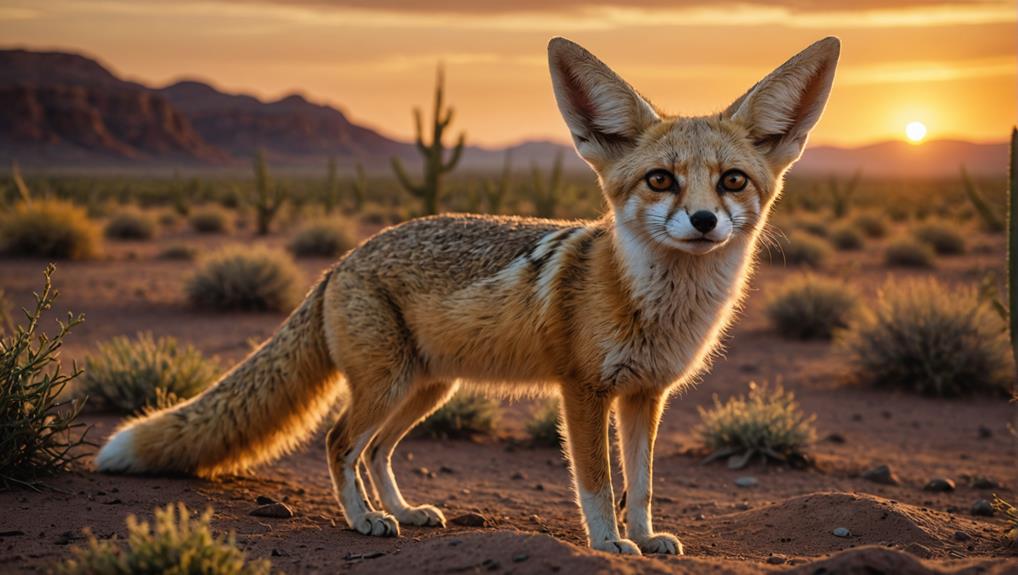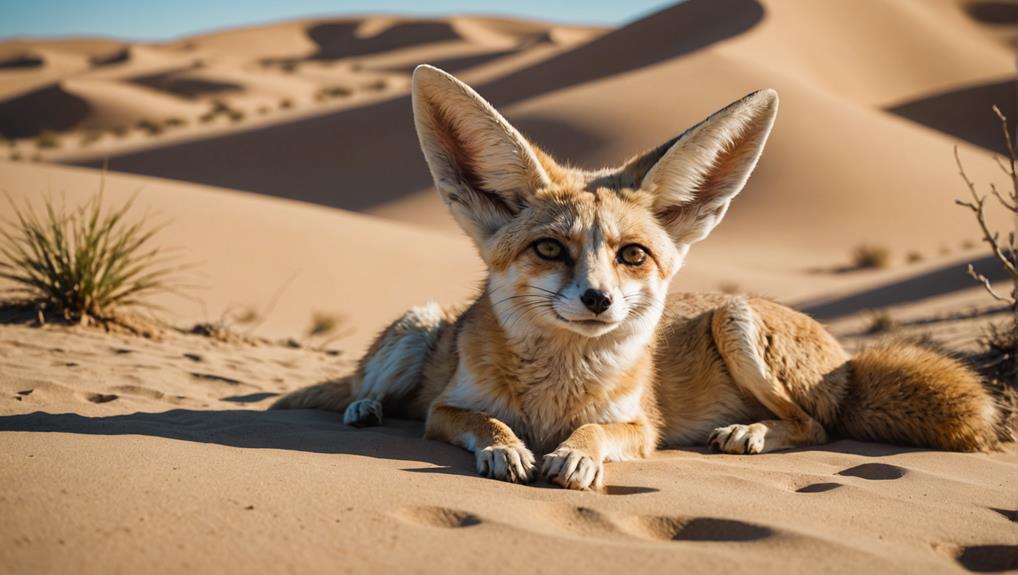The fennec fox picks its habitat based on a few cool essentials. It loves sandy deserts like the Sahara, where it finds the perfect spots for shelter and food. These little furballs prefer burrowing into the ground to escape the heat and have a cozy place to raise their young. Plus, their big ears help them hear dinner coming from a mile away! By choosing areas with scrub for shade and minimal human noise, they can chill during the day and hunt at night. Want to know more about their quirky habits and lifestyle? There's plenty more to uncover!
Contents
Habitat Preferences
When considering a fennec fox's habitat preferences, you'll find that these small, desert-dwelling creatures thrive in sandy environments, particularly in northern Africa's Sahara. They love those soft, sandy deserts where they can easily camouflage and hunt for their next meal.
Imagine the fennec darting around, expertly burrowing into the ground to create cozy underground dens. These dens aren't just for show; they're essential for protection and breeding.
Fennecs prefer arid areas with stabilized sand dunes. Why? Because these spots offer the perfect spots for burrowing and are full of tasty prey.
However, these clever creatures shy away from regions with high human encroachment. Habitat loss can be a big issue for them, leading to increased competition for food and shelter.
They also seek out scrub vegetation, which provides shade from the scorching sun and helps them forage more effectively.
Desert Ecosystems
Fennec foxes aren't just fascinating creatures; they're key players in their desert ecosystems. Living primarily in sandy deserts like the Sahara, these adorable foxes thrive in arid regions where their unique adaptations shine.
You might wonder how they fit into these ecosystems, and here's a peek:
- Sandy terrain offers them excellent foraging opportunities.
- Minimal vegetation creates open spaces perfect for their nocturnal hunts.
- Extreme temperatures during the day and night demand their specialized adaptations.
- Large ears help dissipate heat while also giving them incredible hearing.
- Biodiversity is maintained as they regulate populations of small mammals and insects.
Survival Adaptations

When you think about the Fennec Fox, it's hard not to admire its cool survival tricks!
From its big ears that help keep it cool to its clever nighttime antics, this little fox is built for life in the desert.
Plus, with its sandy coat blending right into the landscape, it's a master of disguise, proving that even the smallest creatures can thrive in tough conditions!
Nocturnal Behavior Benefits
As the sun sets over the Sahara Desert, fennec foxes come alive, showcasing their remarkable adaptations for survival.
Their nocturnal behavior is a clever strategy that helps them thrive in this harsh desert environment. By being active at night, these little foxes dodge the scorching daytime heat and take advantage of cooler temperatures.
Here are some benefits of their nighttime antics:
- They conserve energy by avoiding the extreme heat.
- They reduce the risk of becoming a meal for daytime predators.
- Their large ears help them hear prey moving even from a distance.
- They find insects and small rodents that are also on the hunt for food resources.
- They stay hydrated by getting moisture from their food instead of needing free water.
These adaptations not only help fennec foxes survive but also make them fascinating creatures to observe.
When you think about it, they've turned the desert into their playground, using their wits and skills to thrive under the stars.
Physical Adaptations for Survival
Surviving in the Sahara requires a unique set of physical adaptations that equip the fennec fox for life in extreme conditions. One of its standout features is its large ears, which can grow up to 15 cm (6 inches). These ears aren't just for show; they help the fox cool down during the scorching days while also giving it an edge in hearing prey hiding beneath the sandy surface.
The fennec fox sports a thick fur coat that serves two purposes. It keeps the fox warm during chilly desert nights and reflects sunlight by day. This clever design helps it thrive despite the harsh desert climate.
Its cream-colored coat is a masterclass in camouflage, allowing it to blend right into the sandy landscape, making it harder for predators to spot.
You might find it interesting that these foxes have heavily furred paws. These adaptations help them navigate the hot sand, providing both insulation and traction.
Plus, they don't need direct water sources because they cleverly obtain moisture from their food. Isn't nature just amazing? The fennec fox truly embodies survival in a challenging habitat!
Camouflage and Heat Regulation
Camouflaging effortlessly in the sandy desert, the fennec fox showcases a remarkable coat that blends seamlessly with its surroundings. This sandy cream-colored fur isn't just for show; it helps these clever little desert dwellers avoid predators and sneak up on their dinner.
Plus, their large ears play a dual role, enhancing hearing while also helping with heat regulation.
Here are some cool ways the fennec fox adapts to its harsh habitat:
- Sandy coat: Provides excellent camouflage in the desert.
- Big ears: Help dissipate heat and locate prey.
- Thick paw fur: Insulates against hot sand and offers traction.
- Nocturnal lifestyle: Avoids the scorching sun by hunting at night.
- Low metabolic rate: Conserves energy and allows survival with minimal water.
Nocturnal Behaviors
In the cool embrace of night, the Fennec Fox comes alive, showcasing its unique nocturnal behaviors that help it thrive in the harsh desert environment. By being active after the sun sets, it cleverly avoids the intense heat of the day. Imagine being tucked away in a cozy burrow, then popping out when the air cools, ready for adventure!
With ears that can grow up to six inches long, these little foxes have super hearing! They dart around their habitat, foraging for insects and small mammals, all while using their keen senses to hunt in the dark. Plus, they've got quite the vocal repertoire. You might hear whimpers, barks, and even shrieks as they communicate with family members during their nighttime escapades.
Their burrows, which can stretch up to 32 feet underground, offer a refreshing escape from the heat, making it the perfect hideout.
Dietary Needs

When it comes to the dietary needs of the Fennec Fox, you'll find that these little furballs are quite the opportunistic eaters.
They enjoy a mix of insects, small mammals, and even some plants, making their foraging strategies as flexible as their adorable ears!
Plus, their knack for caching food shows just how clever they're at adapting to their sometimes sparse desert buffet.
Nutritional Requirements
Fennec foxes thrive on a varied diet that caters to their nutritional needs as opportunistic omnivores. You'll find that these clever little creatures adapt their diet based on what's available in their arid habitat. Their nutritional requirements include a mix of proteins, fats, and carbohydrates, all crucial for their survival.
Here's a snapshot of what they typically munch on:
- Small rodents, which provide essential proteins
- Insects like locusts and grasshoppers, their favorite snack
- Birds, adding some variety to their meals
- Vegetation such as roots, fruits, and leaves for hydration and nutrients
- Larger prey, like rabbits, when they're feeling adventurous
In their dry desert environment, fennec foxes cleverly derive hydration from their food, making every bite count. They're not picky eaters; their flexible diet ensures they get what they need to thrive.
Whether in the wild or in captivity, these adorable foxes enjoy a balanced diet that keeps them healthy. So, if you ever get the chance to care for one, remember to serve up a delightful mix of goodies that meets their nutritional needs!
Foraging Strategies
With their keen senses and agile bodies, fennec foxes expertly navigate the sandy terrain in search of food. These adorable nocturnal hunters rely on their incredible hearing, thanks to their large ears, to detect small rodents and insects hiding beneath the surface. Imagine standing in the desert at night, and all you hear is the whisper of the wind while these clever creatures are on a mission to find dinner!
Fennec foxes have some fascinating foraging strategies. They mainly feast on insects, small rodents, lizards, and birds, all of which are plentiful in their arid habitat.
But they don't stop there! They also munch on roots, fruits, and leaves to stay hydrated. Who knew they'd have such a balanced diet?
When the chance arises, they can even tackle prey larger than themselves, like rabbits, showcasing their adaptability. It's like a tiny superhero swooping in for a snack!
With their ability to go long stretches without free water, fennec foxes truly embody the spirit of survival in the desert. By understanding their foraging strategies, we can better appreciate the incredible world of these remarkable creatures.
Prey Availability
In the arid landscapes where fennec foxes roam, prey availability plays a crucial role in their survival.
These clever little creatures have an opportunistic diet, which means they eat whatever food sources they can find. Their habitat is essential, as it determines the abundance of these food sources.
Here's a peek into what fennec foxes typically munch on:
- Small rodents like gerbils and mice
- Crunchy insects such as grasshoppers and locusts
- Reptiles that scurry around the desert floor
- Birds that may nest nearby
- Occasional vegetation, including roots and fruits
Because food can be sporadic in arid environments, fennec foxes don't shy away from adapting their menu.
They're pretty skilled at finding insects, especially during their nighttime adventures when it's cooler. If they're lucky, they might even catch a rabbit!
Their ability to switch up their diet based on prey density helps them thrive despite the challenges of their habitat.
Burrowing Habits
When you think about fennec foxes, their burrowing habits are a fascinating aspect of their survival in harsh desert conditions. These clever little creatures dig complex burrow systems that can stretch up to 32 feet long! Can you imagine that?
This remarkable adaptation provides them shelter from the extreme temperatures of their habitat. During the day, when the sun blazes, fennec foxes retreat into their cozy tunnels, staying cool and hidden from both heat and predators.
Fennec foxes are expert diggers, using their strong forelimbs to create these intricate homes in loose, sandy soil. Inside, they often have distinct nesting chambers built by the females, where they raise their young in safety.
But it's not just about protection; their burrows are also a treasure trove! These underground spaces help them access tasty treats like insect larvae and small rodents, making mealtime a little easier.
Temperature Regulation

Fennec foxes aren't just skilled at digging; they've also developed remarkable adaptations for temperature regulation. Living in the scorching desert, these little critters have some awesome tricks up their furry sleeves to keep their bodies cool and cozy.
- Their large ears, measuring up to 15 cm (6 inches), help dissipate excess heat.
- By being nocturnal, they avoid the extreme daytime temperatures, making the cooler nights their playground.
- Thick fur coats act like insulation against chilly desert nights while reflecting sunlight during the day.
- Hairy soles on their paws give them traction on hot sand and help insulate against heat.
- Their pale coloration isn't just for show; it provides camouflage in the sandy environment, reducing stress from predators.
With these clever adaptations, fennec foxes can thrive in their habitat. They balance the extreme temperatures like pros.
Conservation Challenges
Conservation challenges for the fennec fox are serious and multifaceted. As you dive into the plight of this adorable creature, you'll see that habitat loss from urban development and agriculture is a big issue. Plus, poaching for the exotic pet trade doesn't help either, especially as demand rises. Climate change is throwing a wrench in the works too, messing with food availability and increasing competition among critters.
Here's a quick look at these challenges:
| Challenge | Impact | Solution |
|---|---|---|
| Habitat Loss | Reduces living space | Promote sustainable development |
| Poaching | Decreases wild populations | Raise awareness about the issue |
| Climate Change | Affects food sources | Support climate action efforts |
| Conservation Efforts | Lack of local awareness | Educate communities |
| Legal Protections | Poor enforcement | Strengthen laws & regulations |
Final Thoughts
So, the fennec fox really knows how to pick its home sweet home in the desert! With its special adaptations, nocturnal lifestyle, and clever burrowing habits, it thrives in some pretty harsh conditions. These adorable little critters remind us that nature's design is both fascinating and essential. But let's not forget, they face challenges too. By learning about them, we can help protect their habitats and keep their playful spirit alive. After all, who wouldn't want to save such a cute creature?














